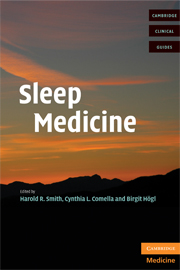Book contents
- Frontmatter
- Contents
- List of contributors
- Foreword
- SECTION 1 NORMAL SLEEP
- SECTION 2 SLEEP DISORDERS
- SECTION 3 SLEEP IN SPECIALTY AREAS
- 9 Sleep and neurologic disorders
- 10 Sleep and psychiatric disorders
- 11 Sleep and medical disorders
- 12 Sleep and pediatrics
- 13 Sleep and geriatrics
- 14 Forensic sleep medicine issues: violent parasomnias
- Index
- References
11 - Sleep and medical disorders
from SECTION 3 - SLEEP IN SPECIALTY AREAS
Published online by Cambridge University Press: 08 August 2009
- Frontmatter
- Contents
- List of contributors
- Foreword
- SECTION 1 NORMAL SLEEP
- SECTION 2 SLEEP DISORDERS
- SECTION 3 SLEEP IN SPECIALTY AREAS
- 9 Sleep and neurologic disorders
- 10 Sleep and psychiatric disorders
- 11 Sleep and medical disorders
- 12 Sleep and pediatrics
- 13 Sleep and geriatrics
- 14 Forensic sleep medicine issues: violent parasomnias
- Index
- References
Summary
Introduction
Addressing sleep disturbance in those who are medically ill should be a high priority. Primary sleep disorders, nocturnal disease symptoms, pain, medications, unhealthy lifestyle factors, depression, anxiety, and stress can all contribute to poor-quality sleep. The resulting sleep disturbance can aggravate the underlying disease process and impair daytime functioning.
In this chapter, we describe both the impact of medical diseases and their treatments on sleep, and how disordered sleep can contribute to medical illnesses. Assessment of sleep disturbance is essential to a 24-hour approach to managing medical illness.
Cardiovascular disease and sleep
Cardiovascular parameters such as blood pressure and heart rate, and cardiovascular events such as myocardial infarction and sudden cardiac death, all show circadian rhythms. Awakening in the morning hours is a stress on the cardiovascular system. The sympathetic nervous system is stimulated, catecholamines are released, and blood pressure surges. These changes are believed to cause an excess incidence of morning myocardial infarctions and sudden cardiac death (Fig. 11.1).
Loss of normal circadian rhythms is also associated with disease. The best example is the case of nocturnal hypertension. Blood pressure normally falls 10–20% at night, commonly termed a “dipper” pattern (Fig. 11.2). “Non-dippers” are usually people with secondary hypertension who have lost their drop in blood pressure during sleep. However, non-dipping also occurs in up to 30% of individuals with essential hypertension. The non-dipper pattern is associated with increased risk of hypertensive end-organ damage – i.e., left ventricular hypertrophy, myocardial infarction, albuminuria, and stroke.
Keywords
- Type
- Chapter
- Information
- Sleep Medicine , pp. 186 - 207Publisher: Cambridge University PressPrint publication year: 2008
References
- 1
- Cited by



